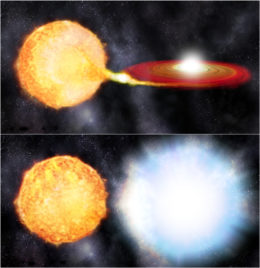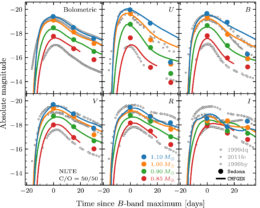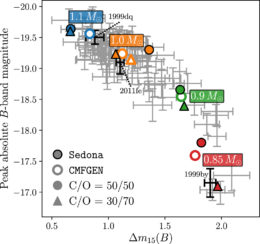Type Ia supernovae are a cornerstone of extragalactic distance measurements, so it’s important that we understand them very well. Right now, we’re fairly certain that Type Ia supernovae are the result of white dwarfs exploding. But how they explode is still an open question.
To Explode a White Dwarf

A creation mechanism for Type Ia supernovae where a white dwarf accretes mass from a companion (upper panel) till it explodes as a supernova (lower panel). [NASA/CXC/M. Weiss]
So how do you make something like a white dwarf explode? Just add mass! If a white dwarf accretes enough matter from a nearby companion, it can approach the Chandrasekhar limit of 1.4 solar masses and explode. This process seems fairly straightforward, but it turns out there are several potential ways to explode a white dwarf.
One scenario involves “double detonation”, where the helium shell of a white dwarf detonates and causes the carbon core to detonate in turn. Another scenario considers white dwarfs in a binary, with one white dwarf accreting material and exploding to knock the other one away.
Interestingly, observations suggest that a combination of these two scenarios — double detonation in white dwarf binaries — may be the likely progenitor of many Type Ia supernovae. One important constraint in this model is that the exploding white dwarf’s mass remains just below the Chandrasekhar limit.
With this in mind, a group of researchers led by Ken Shen (University of California, Berkeley) considered sub-Chandrasekhar-mass explosion scenarios with a tricky but realistic assumption: that local thermodynamic equilibrium (LTE) does not hold.

Model and observed supernova light curves in different bands. The solid lines and the colored circles represent the model, while the unfilled shapes are observed supernovae. The model colors correspond to different white dwarf masses. The white dwarf’s carbon/oxygen ratio was assumed to be 50:50. [Shen et al. 2021]
Explosions Not in Equilibrium
When a system is in LTE, the energies and ionization levels of particles in the system are in some fixed relation with each other while temperature remains consistent across the system. There are astrophysical scenarios where LTE is a safe assumption, like in stars, but LTE certainly doesn’t hold in an event like a supernova.
To model explosions with non-LTE assumptions, Shen and collabors used two different modeling codes. A major difference between the two codes was computation time, and running the same explosion scenarios through both codes allowed Shen and collaborators to determine if the more time-efficient code could stand up to the other. The model outputs included spectra of the ensuing supernovae as well as their light curves across different filters.
Model Matches

A diagram showing the Phillips relation, with peak B-band brightness plotted against the decrease in B-band magnitude 15 days after the peak. Crosses correspond to observations of Type Ia supernovae. The colored shapes correspond to the models, with color representing white dwarf mass, shape representing the carbon/oxygen ratio, and shape outline representing the modeling code used. [Shen et al. 2021]
The model spectra are also good matches to observations, sometimes even out to 30 days after the peak. They are especially accurate near the peak, save for spectral features from “intermediate mass elements”, which generally include elements heavier than carbon up to calcium.
All in all, these initial non-LTE models of sub-Chandrasekhar detonations are an excellent match to a broad range of observed Type Ia supernovae near peak brightness! Future models will have to account for more conditions, but non-LTE seems to be the way to go.
Citation
“Non-local Thermodynamic Equilibrium Radiative Transfer Simulations of Sub-Chandrasekhar-mass White Dwarf Detonations,” Ken J. Shen et al 2021 ApJL 909 L18. doi:10.3847/2041-8213/abe69b

2 Comments
Pingback: Znalezienie odpowiedniego rodzaju eksplozji – PTMA Kraków
Pingback: Znalezienie odpowiedniego rodzaju eksplozji – Astronomia Śląska